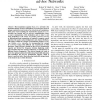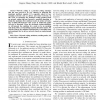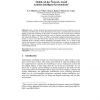109
Voted
CORR
2010
Springer
14 years 9 months ago
2010
Springer
The transmission capacity of an ad-hoc network is the maximum density of active transmitters in an unit area, given an outage constraint at each receiver for a fixed rate of transm...
109
click to vote
OPODIS
2010
14 years 10 months ago
2010
Abstract. Wireless Ad-hoc networks are distributed systems that often reside in error-prone environments. Self-stabilization lets the system recover autonomously from an arbitrary ...
110
Voted
WINET
2010
14 years 10 months ago
2010
In this paper, we present a model that estimates the time duration of routes formed by several intermediate nodes in mobile multi-hop ad-hoc networks. First, we analyze a 3-node ro...
95
Voted
WINET
2008
15 years 9 days ago
2008
Abstract There exist accurate calculation methods for estimation of interference power sum statistics in fixedtopology wireless networks based on the log-normal shadowing radio mod...
121
click to vote
TCOM
2008
15 years 10 days ago
2008
Network coding is a powerful coding technique that has been proved to be very effective in achieving the maximum multicast capacity. It is especially suited for new emerging networ...
147
Voted
JUCS
2006
15 years 11 days ago
2006
: Lately, wireless networks have gained acceptance for home networking. Low cost installation, flexibility and no fixed infrastructures have made it possible home environments rapi...
115
Voted
JUCS
2006
15 years 11 days ago
2006
Abstract: In ad-hoc networks, mobile devices communicate via wireless links without the aid of any fixed networking infrastructure. These devices must be able to discover services ...
135
Voted
ENTCS
2007
15 years 11 days ago
2007
Designing secure protocols over ad-hoc networks has proved to be a very challenging task, due to various features of such networks, such as partial connectivity, node mobility, an...
113
click to vote
DPD
2007
15 years 12 days ago
2007
In a mobile ad-hoc network (MANET), mobile hosts can move freely and communicate with each other directly through a wireless medium without the existence of a fixed wired infrastr...



